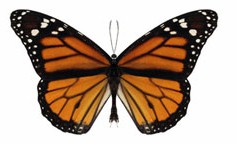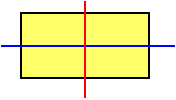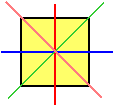Many objects in nature appear the same on the left and right.

The left half of a butterfly appears the same as the right half, and if we were to place a mirror down the center to reflect the left half, the resulting butterfly would look the same as the original:
 |
If we think of the butterfly as a two-dimensional geometric figure, then if we reflect any point on its left side through the vertical line down its center, then we get a corresponding point on the right side. We say the butterfly has line symmetry. That is, it is symmetric with respect to the vertical line through its center.
In general, a geometric figure is symmetric with respect to some line if the reflection of every point through that line is another point on the figure. We say that the figure is "mapped onto itself" by the reflection line.
Figures can have more that one line of symmetry. For example, every rectangle has two lines of symmetry, and every square has 4 lines of symmetry:
 |
 |